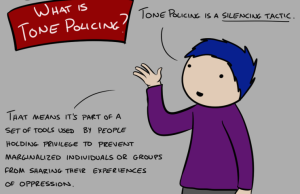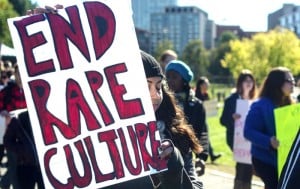The “spicy Latina” stereotype is one that we all know well.
She has a curvy figure, which is accentuated by tight clothing and push-up bras. She has long, wavy hair, and brown skin that’s not too dark. She usually has a thick accent. This accent, usually vilified in real life, becomes something sultry and mysterious, while also being mocked.
But above all, the Latina’s role is to be muy caliente (very hot). Chances are, she could be replaced with one of those “sexy leg” lamps and no one would notice.
Stereotypes are dangerous because they take a group of diverse people and completely flatten them into one-dimensional traits. This stereotype in particular erases the nuances of sexuality and gender, experiences and desires.
Instead, it perpetuates the idea that all Latinas are one homogenous group of exotic woman who are only here for someone else’s pleasure. Worse, it’s often the only portrayal we get of Latinas in the media.
In the words of actress Stephanie Beatriz: “[The Latina is] there to provide contrast, or sexuality, or humor. Or she’s there to clean the floors and/or steal your man. There are some serious stereotypes very much alive in film and TV today, and ‘The Latina’ is one of them.”
Unfortunately, this stereotype has been around for a long time. As Rita Moreno has said, “I made movies for a long time when I was young, and I always had to have an accent. But that wasn’t the worst problem… If I played a Latina, I always had to be too sexy and too easy. I hated that.”
It also doesn’t look like things are going to be changing anytime soon.
A study from the Annenberg School for Communication and Journalism surveyed characters of the 100 top-grossing movies of 2014. In the study, they discovered Latinas are 37.5% more likely to be partially or fully naked on screen than other women; furthermore, 36.1% of Latinas in those movies were wearing “sexualized attire.”
However, this is not the only stereotype about Latinas and our sexuality that television and movies perpetuate. Overwhelming, the hypersexual Latina stereotype is used to describe relatively thin, young, cisgender, and brown (usually mestiza, or folks who have both European and Indigenous ancestry) Latinas.
Latinas who do not share these identities are often erased from media altogether or are stereotyped in different ways.
So here are six more myths about Latina sexuality and identity that dominate on screen:
1. LGBTQIA+ Latinas Don’t Exist
“Little Latin boy in drag, why are you crying?”
One of my first experiences with Latinx queerness was watching John Leguizamo play a drag queen in To Wong Foo, Thanks for Everything! Julie Newmar when I was about four years old.
Unfortunately, I was already grown the first time I saw a queer Latina – Sara Ramirez playing Callie Torres from Grey’s Anatomy – on television. Watching Callie was like a breath of fresh air. Her identity was nuanced. It didn’t revolve around her being an exotic lover, but a woman figuring out who – and what – she liked.
However, Callie is one of the few exceptions in mainstream media.
While there are definitely films out there that explore the complexity of Latinx gender and orientation, this is definitely not the norm in blockbuster films or on television. Overwhelming, Latinas are only portrayed as straight and cisgender.
According to GLAAD, out of all of the LGBTQIA+ characters on 2015 primetime cable shows, only 85 are Latinx. And of those Latinxs, I can’t think of any that are asexual, transgender, and/or intersex.
This is a major problem because it erases the large numbers of LGBTQIA+ Latinas in real life.
For such a long time, I though that not being straight was either a “white people thing” or it was a “phase” because of how rare it was to see queer Latinas on screen.
Representation is important because we, as people, need to see ourselves reflected in what we consume.
It’s especially important for young Latinas who are still discovering their gender and sexuality, because it teaches them that there is more than one way to be. Representation teaches us that we’re not alone – and that in fact, Latinidad carries a huge history of many orientations and genders!
2. White Latinas Are Virginal – And Black Latinas Are Jezebels
Latinx is not a race, but you wouldn’t be able to tell from media.
Light skinned mestiza Latinas, Italians, or other “exotic” non-Latina white actresses usually play the spicy Latina characters that are so pervasive in media. Latina actresses of other races are often erased from the media or their sexualities are portrayed in much different ways.
For example, even though Latin America has a large number of Indigenous, Asian, and Arab populations, we never see Latinx characters represent these folks in the media. Meanwhile, white Latinas and Black Latinas have very different portrayals on screen.
White Latina actresses are rarely sexualized on the basis of their ethnoracial background the way other Latinxs are. For example, actresses like Alexis Bledel and Cameron Diaz have never played Latinas on screen. They often play “the girl next door,” and when they’re sexualized, it’s not in a racialized way.
Their whiteness means that they are not pigeonholed into the “exotic,” sexy roles that many other Latinas are cast as. Meanwhile, roles for Latina characters that are supposed to represent being “innocent” or “virginal” go to non-Latina white women. Two examples are Natalie Wood as Maria in West Side Story and Carey Mulligan as Irene in Drive.
In contrast, Afro-Latinas, as Black actresses, are cast as hypersexualized, Jezebel figures.
When Afro-Latina actors are cast as Latina characters, this sexualization takes on a more “exotic” feeling. The “spicy Latina” trope comes out in full force. However, Afro-Latinas often aren’t cast as Latina at all.
Dark skinned Latinas especially, such as Tatyana Ali, are usually not cast as Latina characters, completely erasing their Latinidad. This anti-blackness is not only a problem across mainstream media, but in the Latinx community in general.
The idea that Latinxs can’t be Black is a form of erasure that whitewashes our histories. It also perpetuates whiteness and light skin as a beauty ideal.
As Gina Torres has said, “When I became an actress, I quickly realized that the world liked their Latinas to look Italian, not like me.”
These representations are dangerous because they homogenous Latinidad.
Latinxs come in a variety of colors, cultures, and ancestry. When the diversity of Latinidad isn’t represented in the media, it says that only light skinned or white Latinxs are the epitome of what Latinxs look like.
Furthermore, the way different Latinas are sexualized reinforces the racialized virgin/whore dichotomy. It goes back to an age-old stereotype that white women must be protected, and Black women must be promiscuous.
And this simply flattens the experiences of Latinas.
3. Latinas Only Date Mestizos or White Men
The first time I saw an ad for Rosewood – which features Morris Chestnut and Jaina Lee Ortiz as the lead characters – my jaw dropped to the floor.
In reality, Latinxs, and our families, are made up of folks of different races, shades, and ethnicities. But in that moment, the only other show I could think of that features a non-Latino Black man and a Latina flirting (and maybe dating?) was Scrubs.
Latinas in the media are usually only paired up with mestizo and other light-skinned Latinos. These Latinos are hypersexualized as well. They are often portrayed as the suave “Latin Lover” or aggressive macho gangster. Typically, Latinas on television are either dating, or have dated, both of these archetypes.
These Latinx couples are used as exotic standards for the white characters to either mock or moon over. And this works to exotify Latinx couples and also portray us as objects for white audiences.
When there is no Latino in the cast, though, Latinas are paired with white men. These white men always use the Latinas as trophies, as if we exist for two reasons. The first is to show that the white man can control the hypersexual Latina. The second is to provide a foil for white women.
Latinas are often called a “home wrecker” or “gold digger.” And these stereotypes are harmful because they reinforce the idea that whiteness is the best quality that a partner can have. It portrays Latinas as trophies for white men.
Sofia Vergara’s character on Modern Family is an example of both of these stereotypes. Benjamin Bratt plays her suave, Latino ex-husband; Ed O’Neill plays her wealthy, white husband.
Both of these stereotypes flatten the diverse kinds of relationships and partnerships that Latinas can have. It also reinforces the idea that Latinas should only be sexual for the purpose of the white gaze; our desires are for entertainment.
4. Our Sexualities Are Directly Tied to Our Jobs
I have two words for you: Devious Maids.
To be fair, I only watched half of an episode before I had to turn it off – for a number of reasons. But the biggest one – besides wondering why it wasn’t called Devious Capitalist Gringos – was how hypersexualized each Latina was as a domestic worker.
Many Latinas, and other migrant women, are domestic workers. It’s hard work with very few benefits. Often, domestic workers spend little time with their own families and have few safety nets in terms of finding other employment.
But that reality is very different then what’s portrayed in the media. Domestic work suddenly becomes a glamour job. The Latinas who portray housekeepers, maids, and nannies often only have one goal: to steal money and/or seduce the man of the house.
This is a dangerous stereotype because it reinforces the idea that Latinas are the exotic, conniving help.
It perpetuates the idea that Latinas are always “on” and ready to have sex, especially at work. We know how to manipulate and control the wealthy, white people who were “gracious” enough to employ us in the first place.
Meanwhile, in reality, domestic workers, especially undocumented women, have little to no protection. Rates of sexual assault against domestic workers are high, with little accountability for the perpetrators, making the media’s sexualization in this case even more disturbing.
5. Latinas Are Always Available for Consumption
Latinas in the media are often compared to food, land, or both.
We’re always “hot tamales.” Our skin is described as “dulce de leche” or “caramel-colored.” With these kinds of descriptions, it’s clear that Latinas aren’t people, but rather, objects. We exist for the pleasure of others only.
But this pleasure is an exotic one. We become things to be tried. We also become things to be claimed.
A prime example of this is Carmen Miranda, who is identifiable to almost anyone on the planet because of her association with fruits and her tropical costumes.
Unlike the white women who we’re contrasted with, our sexuality is shown as something wild. Like a narrative of colonization, we’re something to be tamed. Our own desires have nothing to do with our sexuality; instead, it’s all about how men can take us and conquer us.
Although Latinas are stereotyped as loud, passionate lovers, this never has anything to do with our own pleasures. Latinas are almost never portrayed as saying no to sex; we are always ready to do something sexual, regardless of how we’re feeling.
This stereotype perpetuates rape culture. When Latinas are never represented saying no, we’re not taught how to say no ourselves. And others are never taught how to respect boundaries, because we’re always shown as available for consumption.
6. Our Mothers Are Spicy – And Our Grandmothers Are Chaste
The way Latinas are portrayed in the media also depends on age.
From our teenaged years to when we’re in our forties, Latinas are consistently sexualized.
Often, young Latina characters are the most sexually experienced. Older Latinas are also hypersexualized. These Latinas are always mothers, often raising children by themselves. They wear tight clothing and are constantly going on dates and sleeping with men. However, these Latinas always become very devout, chaste Catholics as soon as they become grandmothers.
These stereotypes place Latinas on an extreme spectrum where suddenly, with age, we go from being completely sexual all the time to having no sex drives at all.
As much as I love Jane the Virgin, it neatly falls into this trope. Andrea Navedo plays the overtly sexual, “spicy” mother, while Ivonne Coll plays the overtly devout, Catholic grandmother.
These stereotypes, especially when working together, are harmful because they again limit the scope of Latina sexuality. They reinforce respectability politics.
The young, out of control mother is represented as ridiculous in comparison to the devout, chaste grandmother. It also places age limits on what it means to be sexual. The older woman is such a devout Christian partly because she is not longer seen as desirable. Whenever Ivonne’s character shows interest in a man, the scene takes on a humorous turn. It implies that older women shouldn’t have needs.
However, someone’s age doesn’t determine their sexuality or desires.
***
None of these portrayals do anything for actual Latinas, and we need to move away from these representations. These tropes not only flatten our experiences, but also perpetuate harmful stereotypes.
We need more Latina characters that show us as we really are – diverse women with many, many different experiences, wants, and sexualities.
[do_widget id=’text-101′]
Jennifer Loubriel is a Contributing Writer for Everyday Feminism. She is a mixed race Afro-Puerto Rican from the Bronx. She is also a queer mujerista and child abuse survivor and a co-founder and moderator over at the Tumblr Women of Color, in Solidarity, a safe space for and by women of color. Jennifer is also an aspiring radical librarian who thinks a lot about policing in community spaces. You can usually find her writing about apocalypse and diaspora, rewatching her favorite TV shows, or taking selfies with her family’s cat.
Search our 3000+ articles!
Read our articles about:
Our online racial justice training
Used by hundreds of universities, non-profits, and businesses.
Click to learn more
Most Read Articles
- « Previous
- 1
- …
- 30
- 31
- 32




















